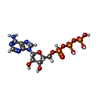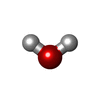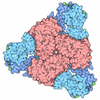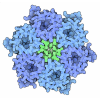[English] 日本語
 Yorodumi
Yorodumi- PDB-9ofb: CryoEM structure of Cad1 bound with cA4 and ATP, symmetry expande... -
+ Open data
Open data
- Basic information
Basic information
| Entry | Database: PDB / ID: 9ofb | |||||||||||||||
|---|---|---|---|---|---|---|---|---|---|---|---|---|---|---|---|---|
| Title | CryoEM structure of Cad1 bound with cA4 and ATP, symmetry expanded dimer refined against a composite map | |||||||||||||||
 Components Components |
| |||||||||||||||
 Keywords Keywords | IMMUNE SYSTEM / HYDROLASE / CRISPR-associated Rossman-fold (CARF) / ATP deaminase / CRISPR immunity / cooperative activation | |||||||||||||||
| Function / homology |  Function and homology information Function and homology informationinosine biosynthetic process / adenosine deaminase / hypoxanthine salvage / adenosine deaminase activity / adenosine catabolic process / cytosol Similarity search - Function | |||||||||||||||
| Biological species |  Thermoanaerobaculum aquaticum (bacteria) Thermoanaerobaculum aquaticum (bacteria) | |||||||||||||||
| Method | ELECTRON MICROSCOPY / single particle reconstruction / cryo EM / Resolution: 2.68 Å | |||||||||||||||
 Authors Authors | Zhao, Y. / Li, H. | |||||||||||||||
| Funding support |  United States, 1items United States, 1items
| |||||||||||||||
 Citation Citation |  Journal: EMBO J / Year: 2025 Journal: EMBO J / Year: 2025Title: The twist-and-squeeze activation of CARF-fused adenosine deaminase by cyclic oligoadenylates. Authors: Charlisa Whyms / Yu Zhao / Doreen Addo-Yobo / Huan He / Arthur Carl Whittington / Despoina Trasanidou / Carl Raymund P Salazar / Raymond H J Staals / Hong Li /   Abstract: The recently identified CARF (CRISPR-associated Rossman-fold) family of proteins play a critical role in prokaryotic defense, mediating cOA (cyclic oligoadenylate)-stimulated ancillary immune ...The recently identified CARF (CRISPR-associated Rossman-fold) family of proteins play a critical role in prokaryotic defense, mediating cOA (cyclic oligoadenylate)-stimulated ancillary immune responses in the type III CRISPR-Cas systems. Whereas most previously characterized CARF proteins contain nucleic acids or protein degradation effectors, a subset of the family, including the CARF-fused adenosine deaminase (ADA) (Cad1), has recently been shown to convert ATP to ITP. The enzymatic mechanism and the activation process of Cad1, however, remain incompletely understood. Here we present biochemical and structural analyses of a ring nuclease Cad1, revealing its substrate binding specificity and a sequential activation process by cOAs. Despite an overall structural similarity to canonical ADA enzymes, the ADA domain of Cad1 possesses unique structural features that confer a specificity for ATP. Supported by mutational analysis, our structural work demonstrates an allosteric link between the cOA-binding CARF and the ADA domain through a protein network within the hexameric enzyme assembly. Binding of a cA4 molecule to paired CARF domains induces a twisting of the linked ADA domains around one another, which remodels their active sites and alters interactions with neighboring ADA domains, thereby driving a sequential conformational activation mechanism. | |||||||||||||||
| History |
|
- Structure visualization
Structure visualization
| Structure viewer | Molecule:  Molmil Molmil Jmol/JSmol Jmol/JSmol |
|---|
- Downloads & links
Downloads & links
- Download
Download
| PDBx/mmCIF format |  9ofb.cif.gz 9ofb.cif.gz | 304.9 KB | Display |  PDBx/mmCIF format PDBx/mmCIF format |
|---|---|---|---|---|
| PDB format |  pdb9ofb.ent.gz pdb9ofb.ent.gz | 197.1 KB | Display |  PDB format PDB format |
| PDBx/mmJSON format |  9ofb.json.gz 9ofb.json.gz | Tree view |  PDBx/mmJSON format PDBx/mmJSON format | |
| Others |  Other downloads Other downloads |
-Validation report
| Summary document |  9ofb_validation.pdf.gz 9ofb_validation.pdf.gz | 1011.1 KB | Display |  wwPDB validaton report wwPDB validaton report |
|---|---|---|---|---|
| Full document |  9ofb_full_validation.pdf.gz 9ofb_full_validation.pdf.gz | 1 MB | Display | |
| Data in XML |  9ofb_validation.xml.gz 9ofb_validation.xml.gz | 39.8 KB | Display | |
| Data in CIF |  9ofb_validation.cif.gz 9ofb_validation.cif.gz | 60.3 KB | Display | |
| Arichive directory |  https://data.pdbj.org/pub/pdb/validation_reports/of/9ofb https://data.pdbj.org/pub/pdb/validation_reports/of/9ofb ftp://data.pdbj.org/pub/pdb/validation_reports/of/9ofb ftp://data.pdbj.org/pub/pdb/validation_reports/of/9ofb | HTTPS FTP |
-Related structure data
| Related structure data |  70422MC  9mmwC  9of1C  9ofcC  9ofdC  9ofeC M: map data used to model this data C: citing same article ( |
|---|---|
| Similar structure data | Similarity search - Function & homology  F&H Search F&H Search |
- Links
Links
- Assembly
Assembly
| Deposited unit | 
|
|---|---|
| 1 |
|
- Components
Components
-Protein / RNA chain , 2 types, 4 molecules ABCD
| #1: Protein | Mass: 69499.133 Da / Num. of mol.: 2 Source method: isolated from a genetically manipulated source Source: (gene. exp.)  Thermoanaerobaculum aquaticum (bacteria) Thermoanaerobaculum aquaticum (bacteria)Gene: EG19_07865 / Production host:  #2: RNA chain | Mass: 675.419 Da / Num. of mol.: 2 / Source method: obtained synthetically / Source: (synth.)  Thermoanaerobaculum aquaticum (bacteria) Thermoanaerobaculum aquaticum (bacteria) |
|---|
-Non-polymers , 4 types, 14 molecules 






| #3: Chemical | | #4: Chemical | #5: Chemical | ChemComp-MG / #6: Water | ChemComp-HOH / | |
|---|
-Details
| Has ligand of interest | Y |
|---|---|
| Has protein modification | N |
-Experimental details
-Experiment
| Experiment | Method: ELECTRON MICROSCOPY |
|---|---|
| EM experiment | Aggregation state: PARTICLE / 3D reconstruction method: single particle reconstruction |
- Sample preparation
Sample preparation
| Component | Name: Cad1 / Type: COMPLEX / Entity ID: #1-#2 / Source: RECOMBINANT |
|---|---|
| Source (natural) | Organism:  Thermoanaerobaculum aquaticum (bacteria) Thermoanaerobaculum aquaticum (bacteria) |
| Source (recombinant) | Organism:  |
| Buffer solution | pH: 7.5 |
| Specimen | Embedding applied: NO / Shadowing applied: NO / Staining applied: NO / Vitrification applied: YES |
| Vitrification | Cryogen name: ETHANE |
- Electron microscopy imaging
Electron microscopy imaging
| Experimental equipment |  Model: Titan Krios / Image courtesy: FEI Company |
|---|---|
| Microscopy | Model: TFS KRIOS |
| Electron gun | Electron source:  FIELD EMISSION GUN / Accelerating voltage: 300 kV / Illumination mode: FLOOD BEAM FIELD EMISSION GUN / Accelerating voltage: 300 kV / Illumination mode: FLOOD BEAM |
| Electron lens | Mode: BRIGHT FIELD / Nominal defocus max: 2500 nm / Nominal defocus min: 820 nm |
| Image recording | Electron dose: 60 e/Å2 / Film or detector model: GATAN K2 QUANTUM (4k x 4k) |
- Processing
Processing
| EM software | Name: PHENIX / Version: 1.20.1_4487 / Category: model refinement | ||||||||||||||||||||||||
|---|---|---|---|---|---|---|---|---|---|---|---|---|---|---|---|---|---|---|---|---|---|---|---|---|---|
| CTF correction | Type: PHASE FLIPPING AND AMPLITUDE CORRECTION | ||||||||||||||||||||||||
| 3D reconstruction | Resolution: 2.68 Å / Resolution method: FSC 0.143 CUT-OFF / Num. of particles: 257900 / Symmetry type: POINT | ||||||||||||||||||||||||
| Refinement | Cross valid method: NONE Stereochemistry target values: GeoStd + Monomer Library + CDL v1.2 | ||||||||||||||||||||||||
| Displacement parameters | Biso mean: 101.69 Å2 | ||||||||||||||||||||||||
| Refine LS restraints |
|
 Movie
Movie Controller
Controller













 PDBj
PDBj




